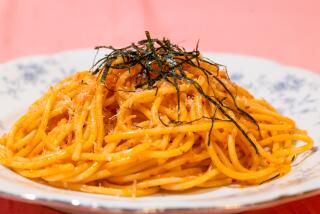When in Rome, Savor Joys of Pasta : Sauces for Italian Favorite Run From Simple to Sublime
- Share via
ROME — A handsome man smiles across the dinner table at the sultry brunet, framed by the soft light of an outdoor terrace. Says the advertising copy:
“The color, the aroma, the taste of these moments . . .”
Anywhere else, the man would puff a cigarette or pour Scotch into crystal tumblers to glorify the pleasures of tobacco or whiskey.
But this is Italy.
So the handsome man is holding a fat forkful of spaghetti. And the copy burbles about the joys of a particular brand of pasta.
Italians take pasta seriously--so seriously that it was front page news last year when a leading Naples pasta maker hired a man who designs Maserati and Ferrari cars to come up with a nouveau noodle.
A Butterfly in Profile
After 35 sketches, industrial designer Giorgetto Giugiaro produced the marille , which looks like a butterfly in profile, the Greek letter beta or a lower case g in script, depending on who is doing the describing.
But whether it’s the new marille, or one of the traditional favorites--spaghetti, spaghettini (thin spaghetti), fettuccine (flat egg noodles), penne (narrow tubes) or fusilli (springs)--Italians slurp it up to the tune of 60 pounds per person a year.
They also know how to cook it: in at least four quarts of water per pound of pasta; in water that is boiling furiously; in water that has been salted liberally--at least 1 1/2 tablespoons of salt per pound of pasta.
Most important, they know when to stop cooking it, which is before it gets soft, mushy, gummy or waterlogged.
Pasta, cooked correctly, does not melt in the mouth. Pasta that doesn’t need chewing is pasta that is overcooked.
And to quote Italian food expert Marcella Hazan, pasta that is overcooked is an abomination. The only thing worse is cold pasta, she says, wishing eternal bowls of chilled spaghetti on cooks who rinse their pasta in cold water after it is done.
Rinsing is unnecessary, the experts say. Simply drain the pasta when it is done in a large colander, then toss immediately in a warm bowl with a sauce.
Simple to Sublime
Italian pasta sauces vary from the simple--olive oil, garlic and hot red peppers--to the sublime--cream, butter, Parmesan cheese and freshly shaved truffles.
Most cook quickly, in about the same time it takes to bring a kettle of water to a rolling boil. The chief exception is the sauce for pasta alla Bolognese, a rich concoction of olive oil, butter, onions, celery, carrots, wine, milk, nutmeg, ground beef, tomatoes and salt, which simmers lazily for four to five hours.
Sauces with a base of cream or butter form another class of toppings.
Melted butter and a handful of Parmesan cheese is perhaps the simplest of these. Butter, beaten until it is light and fluffy, also can be mixed with equal portions of whipping cream and Parmesan and tossed with fettuccine.
Sweet sausage meat can be crumbled and browned and added to melted butter and cream for a heavier sauce that goes well with any of the convoluted pasta shapes, like conchiglie (shells) or farfalle (butterflies), which trap the bits of meat.
For a Lighter Sauce
For an exceptionally light sauce, butter and cream can be mixed with freshly grated lemon peel and poured over tagliolini, extra fine egg noodles.
Sauces with diced vegetables also abound--eggplant chunks combined with tomatoes and olive oil, or cream, butter and bits of cooked artichoke simmered just until the ingredients bind together.
Seafood sauces--olive oil, garlic, baby Mediterranean clams and hot red peppers or briefly sauteed scallops with parsley and olive oil--go best with thin spaghetti so the sauces are not overpowered by their pasta base.
About the only sauce not to be found in Italy is that old American standby, spaghetti and meatballs. Pasta in Italy is always served as a separate course, before the meat and vegetables.
More to Read
Eat your way across L.A.
Get our weekly Tasting Notes newsletter for reviews, news and more.
You may occasionally receive promotional content from the Los Angeles Times.







